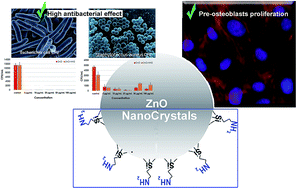Zinc oxide nanocrystals as a nanoantibiotic and osteoinductive agent†
Abstract
In this paper we aim to analyse the behaviour of ZnO nanocrystals (ZnO NCs), prepared with a new synthetic approach and not embedded in any composite matrix, for bone implant applications in vitro. In particular, we have developed a novel, fast and reproducible microwave-assisted synthesis, to obtain highly-crystalline, round-shaped ZnO NCs of 20 nm in diameter as an extremely-stable colloidal solution in ethanol. The nanocrystals were also partially chemically functionalized by anchoring amino-propyl groups to the ZnO surface (ZnO–NH2 NCs). Thus, the role of both ZnO NC concentration and surface chemistry were tested in terms of biocompatibility towards pre-osteoblast cells, promotion of cell proliferation and differentiation, and also in terms of antimicrobial activity against Gram positive and negative bacteria, such as Escherichia coli and Staphylococcus aureus, respectively. The results suggest that ZnO–NH2 NCs is the most promising candidate to solve infectious disease in bone implants and at the same time promote bone tissue proliferation, even at high concentrations. Although further investigations are needed to clarify the mechanism underlying the inhibition of biofilm formation and to investigate the role of the ZnO–NH2 NCs in in vivo assays, we demonstrated that fine and reproducible control over the chemical and structural parameters in ZnO nanomaterials can open up new horizons in the use of functionalized ZnO NCs as a highly biocompatible and osteoinductive nanoantibiotic agent for bone tissue engineering.

- This article is part of the themed collection: Editors' collection: Physical Chemistry of Colloids and Interfaces


 Please wait while we load your content...
Please wait while we load your content...